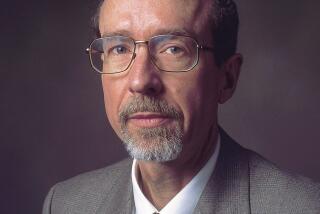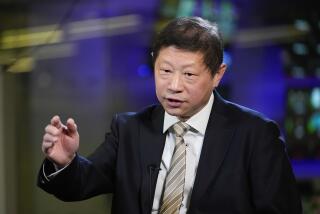An Icon, and Then He’s Gone
- Share via
BEIJING — For many foreigners, he is Tiananmen Square’s most recognizable figure, outshining even Chairman Mao Tse-tung -- whose body still lies in state at a far end of the vast public space.
Just after noon on June 5, 1989, the day after Chinese troops stormed the square to brutally crush a student political uprising here, a solitary protester engaged in a modern-day David versus Goliath showdown: Clutching nothing but two shopping bags, he stood his ground before a column of oncoming tanks on the adjacent Avenue of Eternal Peace.
Captured by newspaper photographs and cable news footage, the tense standoff lasted several minutes, a seeming eternity to onlookers waiting for the tanks to overrun the man, before he was hustled from the scene by onlookers.
On the 15th anniversary of the government crackdown in which hundreds, perhaps thousands, were killed, this lone dissenter’s story remains the most enduring mystery of the violent confrontation.
No one knows whether he’s dead or alive. Chinese activists and government officials say they aren’t even sure of his name. After suddenly emerging to symbolize for the world the fierce power of the individual spirit in the face of martial rule, he vanished.
“For me, he represents the unknown soldier of the Chinese democratic revolution,” said John Kamm, executive director of the Dui Hua Foundation, a San Francisco-based human rights group. “What’s so strange is that his act of bravery was conducted in plain view of the world. But other than seeing his act, we know so very little about him.”
The British tabloid Sunday Express shortly after the incident identified the man as a 19-year-old named Wang Weilin, the son of Beijing factory workers. But activists question the accuracy of a reporter they say did not visit China and relied on telephone calls to supposed friends of the man.
Others say the protester was a nongmin, a peasant from the countryside newly arrived in the city. But no one can say for sure. News footage and photographs showed him only from the back.
In 1999, on the 10th anniversary of the Tiananmen crackdown, Chinese leader Jiang Zemin was asked what had happened to the mystery man. He responded in English, “I think never killed.” Jiang said government officials conducted their own search for the protester, checking morgues, prisons and computer registers, but could not find him.
But they could get no help from Chinese citizens themselves: No one in the country has ever seen the images. In fact, no ordinary Chinese beyond the protesters and soldiers involved even knows of the standoff. Even today, Chinese can’t see the famous photograph, even on the Internet. Attempts to download the picture are blocked by the government.
On the eve of the anniversary this week, Tiananmen Square was crowded with thousands of tourists and locals milling under floodlights -- presumably watched by plainclothes policemen. Brigades of bicyclists passed on the crowded boulevards that surround the square, and a group of old women drew a curious crowd as they exercised to the beat of a drum.
Yet several people nearby said they had never heard of the tank man or his moment of fame.
“I’ve never seen him,” one man said. “Was he Chinese?”
A couple dressed in Western clothing, holding hands as they walked along the sidewalk, said they were too young to recall the incident.
A nearby cab driver in his early 40s was old enough to remember the crackdown. But he said most people had just tried to forget what happened. When told of the exploits of the lone protester, he said, “He must have been a very brave man.”
For the rest of the world, the image remains an icon of freedom. The protester has shown up in a Wim Wenders movie, and his image has been reproduced on posters and T-shirts. In 1998, Time magazine proclaimed him one of the 20th century’s top 20 revolutionaries, whose “moment of self-transcendence [was seen] by more people than ever laid eyes on Winston Churchill, Albert Einstein and James Joyce combined.”
Some believe the man endured months, or years, of political reeducation. Others say he was hunted down and executed.
Human rights activists say that 50 to 100 people were executed in the wake of the Tiananmen Square crackdown -- some for crimes as simple as burning a police motorcycle or, in one case, taking a photograph of the tanks in the square. In addition, 15,000 to 20,000 people were detained.
The activists say 99 still remain in prison for their actions during the protest. China has never acknowledged that civilians died in the bloodshed.
As for the lone protester, activists hope he has survived, but fear the worst.
“Either he’s been killed already or he’s still in some black hole in a Chinese prison,” said Sharon Hom, executive director of the U.S.-based group Human Rights in China. “If he is alive and free, a man willing to stand in front of a tank would have come forward by now and not stay silent. This is not someone who is just going to disappear.”
Activist Robin Munro even called the British reporter who identified the man as Wang Weilin to determine his sources.
“After talking to the journalist for about half an hour, I decided that his story was not reliable,” he wrote in an e-mail from Hong Kong. “It all seemed so incredibly coincidental, and also completely unlikely that a journalist with no China experience, and sitting in London at the time, would be able to identify Tank Man so easily.”
Human rights activist Xiao Qiang calls his inability to locate the protester one of his most frustrating failures. Xiao was studying abroad at the University of Notre Dame when the Tiananmen crackdown occurred.
He watched coverage of the chaos on television, including the footage of the protester’s standoff. Two days later, he returned to China and spent three months there to be with his countrymen at a difficult time.
“This incident changed my life,” said Xiao, who later worked as executive director of Human Rights in China. During 12 years in that job, he twice thought he had found the Tiananmen protester.
Once, in 1993, an Australian lawyer called to say that a man claiming to be Wang Weilin was seeking political asylum there. Xiao telephoned the man and determined that he was an impostor.
Four years later, a group in Texas called to say that it had found the protester, who was seeking asylum in the United States. Again, Xiao talked to the immigrant, who became elusive about details of that day. Then he disappeared.
The man-tank showdown came after months of demonstrations in Tiananmen Square by students decrying such issues as government corruption, lack of free speech and high unemployment.
As tens of thousands of troops from the People’s Liberation Army converged on the square and surrounding areas for cleanup after the first day of attacks, a slender man seemed to appear out of nowhere. As cameras rolled, he positioned himself in front of a column of 18 tanks.
Not far from the spot where in 1949 Mao proclaimed China “a people’s republic,” the man gamely stood his ground. The lead vehicle stopped, spewing exhaust, then moved to the right and left to avoid the defenseless demonstrator. Each time, he stepped up to remain in its path. At some point, he shifted both shopping bags to one hand. Then he jumped onto the tank and appeared to say something to its driver.
“I remember him screaming down the tank hatch at the driver,” said Jeff Widener, at the time an Associated Press photographer, who shot several images of the standoff from a sixth-floor balcony of the nearby Beijing Hotel. “I think the guy was majorly angry and wasn’t thinking straight. I was just waiting for him to get blown away.”
Widener, groggy after being hit in the head the previous day by a brick thrown by a protester, originally thought the man was going to ruin a good image of the advancing tanks. “At first I thought he was going to mess up my photograph,” he said. “Then I realized what was happening.”
Another aspect of the mystery: Why wasn’t he crushed by the tanks, especially since his act of bravery came one day after troops had killed numerous students?
Mickey Spiegel, China specialist at Human Rights Watch, who still hangs a poster of the face-off in her New York office, said, “Nobody even knows that much.”
But Human Rights in China’s Hom believes that another symbol of defiance has been overlooked: the tank driver.
“Both the man in front of the tank and the soldier inside are worthy of our attention,” she said. “Inside, you had a soldier who was obviously not following orders for not running the man down, someone who was probably later harshly disciplined. He obviously saw it as wrong to run over an unarmed man.
“I hope both reflect the future of China, both the willingness to take a stand and the spirit not to follow orders you know are wrong.”
Although the man who defied China’s military might be missing, his legacy remains.
“The whole [Tiananmen Square] incident was a public relations disaster for Beijing, the effects of which continue to this day,” said Richard Baum, director of the Center for Chinese Studies at UCLA. “It has cost the Chinese government enormously, not just in terms of sanctions and abuse accusations abroad, along with U.S. congressional votes against renewing China’s most-favored-nation status, but in the government’s reputation as being the Butchers of Beijing.”
Activists say the world can thank a man on whose identity it can only speculate.
“He was just an average guy who decided that he’s had enough,” said Widener, now a photographer for the Honolulu Advertiser.
“At that moment, he cared more about telling the government to stop the killing than he did his own safety.”
As an outspoken activist now teaching at UC Berkeley, Xiao cannot return to China. But he believes the Tiananmen protester has brought hope to his country.
“Did the tanks win that day, or did that protester show that the human spirit cannot be trampled? I think the jury is not in yet on this question,” he said. “But if you watch Chinese society very closely, you’ll see more courage and independence in people.
“In that way, the spirit of Wang Weilin still lives on.”
More to Read
Sign up for Essential California
The most important California stories and recommendations in your inbox every morning.
You may occasionally receive promotional content from the Los Angeles Times.














